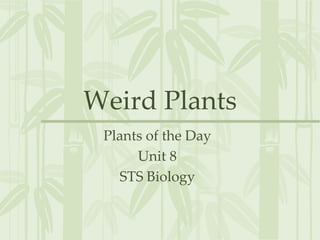
Weird plants 2011
- 1. Weird Plants Plants of the Day Unit 8 STS Biology
- 2. Baseball Plant (Euphorbia Obesa) Succulent – stores water Round shape has optimal surface area/volume ratio to prevent water loss Native to the Great Karoo desert in S. Africa Very endangered in the wild Separate male and female plants produce flowers Pollinated by insects and produces a capsule fruit Has a taproot Male Female Capsules
- 3. Venus Fly Trap (Dionaea muscipula) Carnivorous - insectivore Insects provide minerals and nutrients for the plant – mainly nitrogen Trigger hairs inside the trap cause the “jaws” to close Digestive enzymes break down insects Native to N. and S. Carolina Produces white flowers Found is acidic soils
- 4. Spider Plant (Chlotophytum comosum) Self-propagating “Plantlets” (aka “spider babies”) can take root in soil Produces fleshy tuberous roots Native to South Africa Common houseplant Produces white flowers
- 5. Living Stones (Lithops fulleri) Succulent – plant which has the ability to store water Two fused leaves with few stomata, modified to prevent evaporation Mimics the color and appearance of rocks – less obvious to foraging animals Produces yellow or white flowers Native to S. Africa and Namibia
- 6. Sensitive Plant (Mimosa pudica) Leaves fold inward when touched (thigmonasty) Mechanism believed to related to changes in osmotic pressure in cells where leaflets join Thought to be a defense mechanism against grazers Native to Brazil Produces purple flowers In the pea family – nitrogen fixer
- 7. Marimo Moss Balls (Aegagropilalinnaei) Not moss!!! A filamentous algae that forms balls in specific lakes in Japan, Iceland, Scotland, and Estonia Wave currents, lake morphology, and sediment at the bottom of the lake form algae into balls Adapted to low light Chloroplasts inside the ball are dormant unless the ball breaks apart An annual festival at Lake Akan in Japan honors them and raises awareness about conservation issues
- 8. Air Plant (Tillandsiastricta) Epiphyte – plants that are not rooted in soil Grow in rocks, loose bark, or on trees Obtain water and nutrients from the air Trichomes – gray scales on the leaf surface which store water and reflect intense sun to prevent water loss due to transpiration Same family as the Bromeliad and pineapple Native to Mexico & Central America
- 9. Madagascar Palm (Pachypodiumlamerei) A succulent, not a palm! Has prickly spines like a cactus AND foliage like a palm Looses it’s leaves and goes dormant in the winter Produces white flowers and cucumber-like fruits Needles prevent foraging animals Can grow up to 15 ft. in nature Survives in a diverse climates
- 11. Leaves mimic flowers, tricking insects to crawl in
- 12. Insects drown in pitcher-shaped leaves
- 13. Bacteria within the plant break down insects with digestive enzymes - symbiosisDownward pointing hairs prevent insects from crawling out Produces burgundy flowers Native to bogs of northeastern USA
- 14. String of Pearls (Seneciorowleyan) Succulent Same family as a sunflower Native to dry regions in SW Africa Leaf shape reduces surface area to prevent water loss External “window” of transparent tissue allows light to enter and be absorbed by the photosynthetic cells inside. The central core of each leaf contains non-pigmented water storage cells.
- 15. Banana Plant (Nymphoidesaquatica) Has banana shaped roots called rhizomes which store nutrients Aquatic, related to water lilies Native to shallow waters in the Southern region on the USA along the Gulf of Mexico and the Atlantic Oceans Common aquarium plants
Notas do Editor
- succulent beads are actually the leaves, modified for living through extended periods of drought. Dr. T. Ombrello of Union County College has written an intriguing article on the adaptations of this Senecio and the closely related Senecioherreianus, entitled Senecios, With Windows in Their Leaves. The narrow bands you can see on some of the beads consist of transparent tissue to allow light to penetrate the interior of the bead and increase photosynthesis without increasing water loss. http://faculty.ucc.edu/biology-ombrello/POW/Senecios.htm